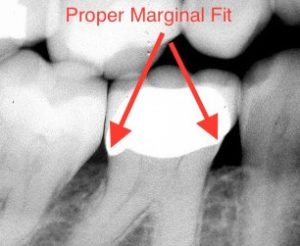Your crown looked and felt great when you got it, but recently you’ve noticed a dark line along the gumline. You might wonder if this is due to decay, a poor fit, or possibly that something is wrong with the underlying tooth structure. Why is it there?
Well, it could be a few different things, but they all begin with gum recession.
What is gum recession? It is when the gums around the crowned tooth have receded or shrunk back. It can be caused by overbrushing, by periodontal disease, by tooth grinding or by the shifting of teeth when other teeth around it are lost or altered, sometimes affecting it. And, sometimes, it’s just from plain old aging! Even the slightest amount of gum recession can expose the margin of a crown that was under the gum when the crown was originally placed.
The margin of a crown is where the edge of the crown meets your gum. It should be thin, smooth and even, and it should meet the edge of the root of the tooth seamlessly. It should fit precisely and smoothly for a clean seal.
In most situations, this dark line you see is simply due to the type of margin the crown was fabricated with, (metal) and that margin becoming exposed. Porcelain fused to metal (PFM) crowns are among the most common crowns made. Until relatively recently, metal margins were the norm, and over time, even with only minimal gum recession, the metal margins become visible, resulting in an ugly dark line.
Sometimes, however, what you see is actually the exposed natural tooth and/or root structure under the crown. When the gum tissue shrinks, the edges can become exposed and prone to staining. When a tooth has had a root canal prior to having a crown, the tooth darkens over time and with any gum recession, will appear dark in color.
Another cause for this is decay. Patients often have the misconception that these restorations are immune to decay, but this is not the case. The margins are particularly vulnerable to decay, which is why good oral hygiene is necessary to make them last decades. It’s important to have your crowns checked regularly by your dentist to ensure that the margins’ seal is still solid, protecting the tooth underneath from decay.
WHAT I CAN DO ABOUT THE BLACK LINES?
If the metal margin of your porcelain-fused-to-metal crown is to blame for the black line, you can consider replacing it with an all-porcelain crown.
If you do not have a PFM crown, it’s worth a trip to the dentist to have it evaluated, to determine if the dark line is from staining or from decay. If it IS decayed, it will need to be replaced in order to remove the decay and save the tooth. If the fit is still intact and *it’s simply only stains you’re seeing? That’s more of an aesthetic concern. With this information, you can decide whether or not to replace it. (*But if this is the case, you will need to be very diligent with your oral hygiene routine, being sure to keep it very well brushed and flossed, AND checked on regularly by your dentist. Remember, this part of the tooth is softer than enamel and more prone to decay, so it’s imperative to keep a VERY CLOSE eye on it to avoid surprise problems.)
See your dentist for an exam to determine what is causing the dark line, then you can decide on the best course of treatment.
TAKING CARE OF YOUR CROWNS
It’s important to stay on a regular cleaning and check-up schedule if you have crowns, so we can keep an eye on the margins of your crowns and keep the supporting bone and gums healthy.
As far as taking care of them at home: Brush twice a day with a soft-bristled or electric toothbrush and floss regularly and your crowns can last decades.
ADVICE FOR FUTURE CROWNS
When it comes to crowns lasting a LONG time: Poorly fitting crowns with imperfect margins are a big problem, and one you don’t often find out about until years later, so it’s important if you’re going to get crowns, to be sure and have them done by a dentist who is really good at doing them. Preferably, by a Prosthodontist, as this is our specialty, and definitely not a dentist who uses a cheap lab! It’s not as easy as it should be, so do your homework on the dentist you choose before having this type of restoration done. Additionally, it would be a good idea to ask to see their x-ray of the crown when it’s put in, to verify the fit. The margin should be nice and clean and smooth, like in this picture:
 NOT like this:
NOT like this: 

